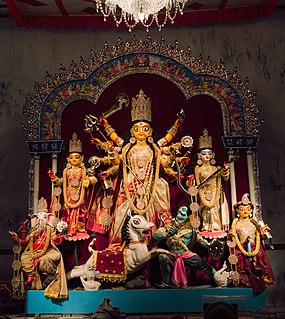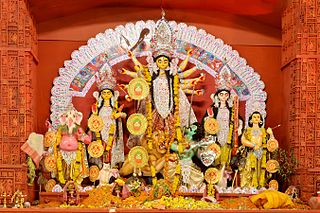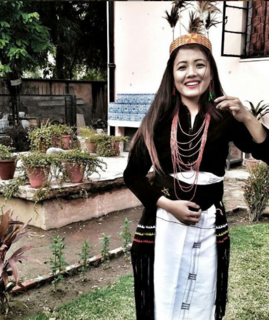
Puja or pooja is a worship ritual performed by Hindus to offer devotional homage and prayer to one or more deities, to host and honour a guest, or to spiritually celebrate an event. It may honour or celebrate the presence of special guest(s), or their memories after they die. The word "pūjā" is Sanskrit, and means reverence, honour, homage, adoration and worship. Puja, the loving offering of light, flowers, and water or food to the divine, is the essential ritual of Hinduism. For the worshipper, the divine is visible in the image, and the divinity sees the worshipper. The interaction between human and deity, between human and guru, is called darshan, seeing.

Durga Puja, also called Durgotsava, is an annual Hindu festival originating in the Indian subcontinent which reveres and pays homage to the Hindu goddess, Durga. It is particularly popular and traditionally celebrated in the Indian states of West Bengal, Bihar, Assam, Odisha, Tripura and the country of Bangladesh, and the diaspora from this region, and also in Mithilanchal regions of Bihar and Nepal. The festival is observed in the Indian calendar month of Ashwin, which corresponds to the months of September–October in the Gregorian calendar, and is a ten-day festival, of which the last five are of significance. The puja is performed in homes and in the public, the latter featuring temporary stage and structural decorations. The festival is also marked by scripture recitations, performance arts, revelry, gift giving, family visits, feasting, and public processions. Durga puja is an important festival in the Shaktism tradition of Hinduism.
The tribes of Jharkhand consist of 32 Schedule Tribe inhabiting the Jharkhand state in India. In 1872, only 18 tribes were annexed in the schedule tribe from which Banjara, Bhatudi, Chik Baraik and Mahli were marked as semi-Hindu aboriginal and Kora as prolaterate Hindu. In 1931 census, including above four semi-Hindu aboriginal and Kora, a prolaterate Hindu, the number raised to 26 from 18 by adding four more in the annexure. They were Birajia, Godait, Karmali and Paharia, but Kisan excluded from list of 18th. In 1941 census, Baga, Bedia and Lohra included again taking Kisan in the annexure and number cames to 30th which was preveling till June 2003. Kanwar and Kol added on 8 June 2003 in the annexure and number of Schedule Tribe came to 32.
- Asur
- Baiga
- Banjara
- Bathudi
- Bedia
- Binjhia
- Birhor
- Birjia
- Chero
- Chik Baraik
- Gond
- Gorait
- Ho
- Karmali
- Kharia
- Kharwar
- Khond
- Kisan
- Kora
- Korwa
- Lohra
- Mahli
- Mal Pahariya
- Munda
- Oraon
- Parhaiya
- Santhal
- Sauria Paharia
- Savar
- Bhumij
- Kol
- Kanwar
Kham is the name of a set of languages in the Khams Tibetan sub-group of the Tibeto-Burman languages. The people call themselves both Kham and Magar while they are called Kham Magar, Western Magar, or simply Magar by outsiders. The name ‘Magar,’ may derive from the same etyma as the Old Tibetan mgar-ba, meaning ‘smith.’ The language was previously sometimes called "Western magar" but Kham Magar and Magar are now known to be quite different languages. Kham Magar communities live in the Middle Hills of mid-western Nepal, in the districts of Rukum, Rolpa, and Baglung. Scattered communities also live in Jajarkot, Dailekh, Kalikot, Achham, and Doti districts.
The Tà Ôi is an ethnic group of Vietnam and Laos.
Kolkata has many festivals throughout the year. Durga Puja is the largest festival of West Bengal, and it features colourful pandals, decorative idols of Hindu goddess Durga and her family, lighting decorations and fireworks. Other major festivals are Diwali, Kali Puja, Holi, Saraswati Puja, Poush Parbon, Poila Boishakh, etc.

Aadi Perukku commonly known as the Aadi monsoon festival and also written as Aadiperukku is a Tamil festival celebrated on the 18th day of the Tamil month of Adi. The festival pays tribute to water's life-sustaining properties. For the blessing of mankind with peace, prosperity and happiness, nature worship in the form of Amman deities are organized to shower Nature’s bountiful grace on human beings.
Dashain, also Bijaya Dashami) is a festival originating from Nepal. In other parts of South Asia, it is called Dashain. Dashain is celebrated by the Hindus of Nepal and the Nepali language speaking people of the Darjeeling hills, Sikkim, Siliguri, Assam and other North-Eastern states of India and among the Lhotshampa of Bhutan and the Burmese Gurkhas of Myanmar. Many people of Nepal celebrate this festival. It is famous in Hindu region.
Reang are one of the Tripuri clan of Indian state of Mizoram and Tripura. The Bru can be found all over the Tripura state in India. However, they may also be found in Assam. They speak the Reang dialect of Kokborok language which is of Tibeto-Burmese origin and is locally referred to as Kau Bru.

The Maa Sarala Temple is a Hindu temple in the district of Jagatsinghpur, Odisha, India. It is one of the eight most famous Shakta shrines of Odisha.

Goddess Ankalamma, or Angalamma, is also known as Ankamma or Angamma, Ankali, Angali, Ankala Parameswari and Angala Parameswari.Charapalli Balaji from dinnemeeda palli was one of the great devote of Ankalamma.She is worshipped with these names in Andhra Pradesh, Karnataka and Tamil Nadu.Most people in Tamilnadu keep their name as "Angu" by the influence of the god.

Lakshmi Puja or Lakshmi Pooja, is a Hindu religious festival that falls on Amavasya of Krishna Paksha in the Vikram Samvat Hindu calendar month of Kartik, on the third day of Deepawali and is considered as the main festive day of Deepawali.

Ayudha Puja is a part of the Navratri festival, a Hindu festival which is traditionally celebrated in India. It is also called "Astra Puja". In simple terms, it means “Worship of Instruments”. It is celebrated in Tamil Nadu as Ayudha Pujai, in Telangana and Andhra Pradesh as Aayudha Pooja, in Kerala as Ayudha Puja, "Astra Puja" or "Ayudha Puja" in Odisha, "Shastra Puja" or "Ayudha Puja/ Khande Navami" in Maharashtra, and in Karnataka as “Ayudha Puje”. The festival falls on the tenth day of the bright half of Moon's cycle of 15 days in the month of September/October, and is popularly a part of the Dasara or Navaratri or Durga Puja or Golu festival. On the tenth day of the Dasara festival, weapons and tools are worshipped. In Karnataka, the celebration is for killing of the demon king Mahishasura by goddess Durga. After slaying of the demon king, the weapons were kept out for worship. While Navaratri festival is observed all over the country but in South Indian states, where it is widely celebrated as Ayudha Puja, there are slight variations of worship procedure.

Navaratri is a Hindu festival that spans nine nights and is celebrated every year in the autumn. It is observed for different reasons and celebrated differently in various parts of the Indian cultural sphere. Theoretically, there are four seasonal Navaratri. However, in practice, it is the post-monsoon autumn festival called Sharada Navaratri that is the most observed in the honor of the divine feminine Devi (Durga). The festival is celebrated in the bright half of the Hindu calendar month Ashvin, which typically falls in the Gregorian months of September and October.

Kali Puja, also known as Shyama Puja or Mahanisha Puja, is a festival, originating from the Indian subcontinent, dedicated to the Hindu goddess Kali, celebrated on the new moon day of the Hindu month Kartik especially in the regions of Bengal, and in Mithila, Odisha, Assam and the town of Titwala in Maharashtra. It coincides with the Lakshmi Puja day of Diwali. While the Hindu Bengalis, Odias, Assamese and Maithils worship the goddess Kali on this day, the rest of India and Nepal worships goddess Lakshmi on Diwali.

The Maring are one of the people ethnic group inhabiting Manipur State in North-East India. Their name is derived from mei meaning fire and ring meaning to start or produce. The people of Maring tribe are called Maringa. A mainly Christian people, they live chiefly in Tengnoupal district and nearby areas.
Kharchi Puja is a Hindu festival from Tripura, India. Performed in Agartala in July or August, the festival involves the worship of the fourteen gods forming the dynasty deity of the Tripuri people. Kharchi Puja is one of the most popular festivals in Tripura. It's a week-long royal Puja which falls in the month of July on the eighth day of the new moon and attracts thousands of people. This festival is celebrated at Agartala in the temple premises of Fourteen gods. There are many legends associated with this Puja. The celebrations extend until a week and are held in the temple premises which are attended by thousands of people.

Swanti is a five-day festival of Nepal which is one of the year's greatest celebrations for the Newar people. It is the Newar version of Tihar or Diwali. The festival highlights the central role of women in the household, and the rituals are related to wishing for good fortune of the family members by presenting them auspicious items and praying for longevity by placating the god of death.

Karam or Karma is a harvest festival celebrated in Indian states of Jharkhand, Bihar, Madhya Pradesh, Chhattisgarh, Assam, Odisha and West Bengal. It is dedicated to the worship of Karam-Devta (Karam-Lord/God), the god of power, youth and youthfulness. The Karam festival celebrated by diverse groups of people, including: the Kharia, Korba,Kuli/Kulis [Odisha] Baiga, Binjhwari, Nagpuri, Khortha, Kudumi, Oraon, Munda, Santal and many more. The festival is held on the 11th day of a full moon (Purnima) of the Hindu month of Bhado (Bhadra), which falls between August and September. Groups of young villagers go to the jungle and collect wood, fruits, and flowers. These are required during the puja (worship) of the Karam God. During this period, people sing and dance together in groups. The entire valley dances to the drumbeat "day of the phases".

Badadungiriguda is a village in Odisha, India. It is located in the Karlamunda block of the Kalahandi district. It comes under the administration of the Gajabahal gram panchayat.













